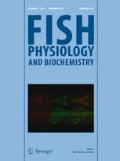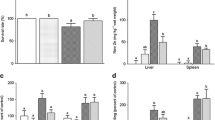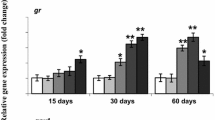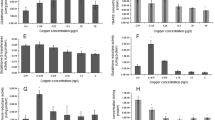Abstract
The aim of the present study was to assess survival rate, Zn accumulation, reactive oxygen species (ROS) levels, oxidative damage and antioxidant responses after Zn exposure (2 and 8 mg L−1 Zn) at different exposure times (6, 12, 24, 48 and 96 h) in the liver of large yellow croaker. Survival rate was reduced at 96 h, and hepatic Zn content increased during 24–96 by 8 mg L−1 Zn. In the 2 mg L−1 Zn group, no fish died and the increase in Zn content merely occurred at 96 h. Exposure to 8 mg L−1 Zn induced accumulation of ROS, lipid peroxidation and protein carbonylation during the late stage of exposure. In contrast, exposure to 2 mg L−1 Zn did not result in oxidative damage, which may result from the up-regulation of antioxidant defenses. Although exposure to 8 mg L−1 Zn increased activities and mRNA levels of antioxidant enzymes during the early stage of exposure, including Cu/Zn–SOD, Mn–SOD, CAT, GPx and GR, the activities of these enzymes except Cu/Zn–SOD were inhibited at 96 h. Furthermore, a sharp increase in Nrf2 expression was observed in fish exposed to 8 mg L−1 at 6 and 12 h, and 2 mg L−1 at 12 h and 24 h, suggesting that Nrf2 was required for the protracted induction of these genes. The late increase in Keap1 expression may support its role in switching off the Nrf2 response. In conclusion, the present study demonstrated different effects of low- and high-dose waterborne Zn on antioxidant responses, which could contribute to the understanding of antioxidant and toxic roles of zinc on a molecular level.




Similar content being viewed by others
References
Adeyemi JA, Klerks PL (2013) Occurrence of copper acclimation in the least killifish Heterandria formosa, and associated biochemical and physiological mechanisms. Aquat Toxicol 130:51–57
An KW, Shin HS, Choi CY (2008) Physiological responses and expression of metallothionein (MT) and superoxide dismutase (SOD) mRNAs in olive flounder, Paralichthys olivaceus exposed to benzo[a]pyrene.Comp. Biochem Physiol B Biochem Mol Biol 149:534–539
Atli G, Alptekin O, Tukel S, Canli M (2006) Response of catalase activity to Ag+, Cd2+, Cr6+, Cu2+ and Zn2+ in five tissues of freshwater fish Oreochromis niloticus. Comp Biochem Physiol C Pharmacol Toxicol 143:218–224
Baird L, Dinkova-Kostova AT (2011) The cytoprotective role of the Keap1–Nrf2 pathway. Arch Toxicol 85:241–272
Beauchamp C, Fridovich I (1971) Superoxide dismutase: improved assays and an assay applicable to acrylamide gels. Anal Biochem 44:276–287
Beutler E (1982) Catalase. Red cell metabolism, a manual of biochemical methods, pp 105–106
Bradford MM (1976) A rapid and sensitive method for the quantitation of microgram quantities of protein utilizing the principle of protein-dye binding. Anal Biochem 72:248–254
Cho YS, Choi BN, Kim KH, Kim SK, Kim DS, Bang IC, Nam YK (2006) Differential expression of Cu/Zn superoxide dismutase mRNA during exposures to heavy metals in rockbream (Oplegnathus fasciatus). Aquaculture 253:667–679
Cho YS, Lee SY, Bang IC, Kim DS, Nam YK (2009) Genomic organization and mRNA expression of manganese superoxide dismutase (Mn–SOD) from Hemibarbus mylodon (Teleostei, Cypriniformes). Fish Shellfish Immunol 27:571–576
Copple IM, Goldring CE, Kitteringham NR, Park BK (2008) The Nrf2–Keap1 defence pathway: role in protection against drug-induced toxicity. Toxicology 246:24–33
Craig PM, Wood CM, McClelland GB (2007) Oxidative stress response and gene expression with acute copper exposure in zebrafish (Danio rerio). Am J Physiol Regul Integr Comp Physiol 293:R1882–R1892
Dolci G, Vey L, Schuster A, Roversi K, Roversi K, Dias V, Pase C, Barcelos R, Antoniazzi C, Golombieski J (2014) Hypoxia acclimation protects against oxidative damage and changes in prolactin and somatolactin expression in silver catfish (Rhamdia quelen) exposed to manganese. Aquat Toxicol 157:175–185
Drotar A, Phelps P, Fall R (1985) Evidence for glutathione peroxidase activities in cultured plant cells. Plant Sci 42:35–40
Eroglu A, Dogan Z, Kanak E, Atli G, Canli M (2014) Effects of heavy metals (Cd, Cu, Cr, Pb, Zn) on fish glutathione metabolism. Environ Sci Pollut R 22:3229–3237
Fu H, Steinebach OM, Van den Hamer CJA, Balm PHM, Lock RAC (1990) Involvement of cortisol and metallothionein-like proteins in the physiological responses of tilapia, Oreochromis mossambicus to sub-lethal cadmium stress. Aquat Toxicol 16:257–270
Gallego A, Martin-González A, Ortega R, Gutierrez JC (2007) Flow cytometry assessment of cytotoxicity and reactive oxygen species generation by single and binary mixtures of cadmium, zinc and copper on populations of the ciliated protozoan Tetrahymena thermophila. Chemosphere 68:647–661
Giuliani ME, Regoli F (2014) Identification of the Nrf2–Keap1 pathway in the European eel Anguilla anguilla: role for a transcriptional regulation of antioxidant genes in aquatic organisms. Aquat Toxicol 150:117–123
Halliwell B, Gutteridge JM (1999) Free radicals in biology and medicine. Oxford University Press, Oxford
Hansen B, Romma S, Garmo Ø, Olsvik P, Andersen R (2006) Antioxidative stress proteins and their gene expression in brown trout (Salmo trutta) from three rivers with different heavy metal levels. Comp Biochem Physiol C Pharmacol Toxicol 143:263–274
Heath AG (1995) Water pollution and fish physiology. CRC Press, Boca Raton
Huang C, Chen QL, Luo Z, Shi X, Pan YX, Song YF, Zhuo MQ, Wu K (2014) Time-dependent effects of waterborne copper exposure influencing hepatic lipid deposition and metabolism in javelin goby Synechogobius hasta and their mechanism. Aquat Toxicol 155:291–300
Jiang WD, Liu Y, Hu K, Jiang J, Li SH, Feng L, Zhou XQ (2014) Copper exposure induces oxidative injury, disturbs the antioxidant system and changes the Nrf2/ARE (CuZnSOD) signaling in the fish brain: protective effects of myo-inositol. Aquat Toxicol 155:301–313
Jiang WD, Liu Y, Jiang J, Wu P, Feng L, Zhou XQ (2015) Copper exposure induces toxicity to the antioxidant system via the destruction of Nrf2/ARE signaling and caspase-3-regulated DNA damage in fish muscle: amelioration by myo-inositol. Aquat Toxicol 159:245–255
Kang SW, Rhee SG, Chang TS, Jeong W, Choi MH (2005) 2-Cys peroxiredoxin function in intracellular signal transduction: therapeutic implications. Trends Mol Med 11:571–578
Kobayashi M, Itoh K, Suzuki T, Osanai H, Nishikawa K, Katoh Y, Takagi Y, Yamamoto M (2002) Identification of the interactive interface and phylogenic conservation of the Nrf2–Keap1 system. Genes Cells 7:807–820
LeBel CP, Ischiropoulos H, Bondy SC (1992) Evaluation of the probe 2′, 7′-dichlorofluorescin as an indicator of reactive oxygen species formation and oxidative stress. Chem Res Toxicol 5:227–231
Lee OH, Jain AK, Papusha V, Jaiswal AK (2007) An auto-regulatory loop between stress sensors INrf2 and Nrf2 controls their cellular abundance. J Biol Chem 282:36412–36420
Li J, Stein TD, Johnson JA (2004) Genetic dissection of systemic autoimmune disease in Nrf2-deficient mice. Physiol Genomics 18:261–272
Liu P, Yu Y, Liu C (1991) Studies on the situation of pollution and countermeasures of control of the oceanic environment in Zhoushan fishing ground—the largest fishing ground in China. Mar Pollut Bull 23:281–288
Livingstone D, Martinez PG, Michel X, Narbonne J, Ohara S, Ribera D, Winston G, (1990) Oxyradical production as a pollution-mediated mechanism of toxicity in the common mussel, Mytilus edulis L., and other molluscs. Funct Ecol 4:415–424
Loro VL, Jorge MB, da Silva KR, Wood CM (2012) Oxidative stress parameters and antioxidant response to sublethal waterborne zinc in a euryhaline teleost Fundulus heteroclitus: protective effects of salinity. Aquat Toxicol 110:187–193
Lushchak VI, Bagnyukova TV, Husak VV, Luzhna LI, Lushchak V, Storey KB (2005) Hyperoxia results in transient oxidative stress and an adaptive response by antioxidant enzymes in goldfish tissues. Int J Biochem Cell B 37:1670–1680
Martínez-Reyes I, Cuezva JM (2014) The H+-ATP synthase: a gate to ROS-mediated cell death or cell survival. BBA-Bioenergetics 1837:1099–1112
McGeer JC, Nadella S, Alsop DH, Hollis L, Taylor LN, McDonald DG, Wood CM (2007) Influence of acclimation and cross-acclimation of metals on acute Cd toxicity and Cd uptake and distribution in rainbow trout (Oncorhynchus mykiss). Aquat Toxicol 84:190–197
Murphy MP (2009) How mitochondria produce reactive oxygen species. Biochem J 417:1–13
Nam YK, Cho YS, Choi BN, Kim KH, Kim SK, Kim DS (2005) Alteration of antioxidant enzymes at the mRNA level during short-term starvation of rockbream Oplegnathus fasciatus. Fish Sci 71:1385–1387
Pfaffl MW (2001) A new mathematical model for relative quantification in real-time RT–PCR. Nucleic Acids Res 29:e45–e45
Pick E, Keisari Y (1981) Superoxide anion and hydrogen peroxide production by chemically elicited peritoneal macrophages—induction by multiple nonphagocytic stimuli. Cell Immunol 59:301–318
Prasad AS (2014) Zinc: an antioxidant and anti-inflammatory agent: role of zinc in degenerative disorders of aging. J Trace Elem Med Biol 28:364–371
Qu R, Feng M, Wang X, Qin L, Wang C, Wang Z, Wang L (2014) Metal accumulation and oxidative stress biomarkers in liver of freshwater fish Carassius auratus following in vivo exposure to waterborne zinc under different pH values. Aquat Toxicol 150:9–16
Regoli F, Giuliani ME (2014) Oxidative pathways of chemical toxicity and oxidative stress biomarkers in marine organisms. Mar Environ Res 93:106–117
Sampaio FG, de Lima Boijink C, Oba ET, dos Santos LRB, Kalinin AL, Rantin FT (2008) Antioxidant defenses and biochemical changes in pacu (Piaractus mesopotamicus) in response to single and combined copper and hypoxia exposure. Comp Biochem Physiol C Pharmacol Toxicol 147:43–51
Sarkar S, Mukherjee S, Chattopadhyay A, Bhattacharya S (2014) Low dose of arsenic trioxide triggers oxidative stress in zebrafish brain: expression of antioxidant genes. Ecotox Environ Safe 107:1–8
Shi X, Zhou B (2010) The role of Nrf2 and MAPK pathways in PFOS-induced oxidative stress in zebrafish embryos. Toxicol Sci 115:391–400
Sun S, Ge X, Zhu J, Xuan F, Jiang X (2014) Identification and mRNA expression of antioxidant enzyme genes associated with the oxidative stress response in the Wuchang bream (Megalobrama amblycephala Yih) in response to acute nitrite exposure. Comp Biochem Physiol C Pharmacol Toxicol 159:69–77
Sun Z, Zhang S, Chan JY, Zhang DD (2007) Keap1 controls postinduction repression of the Nrf2-mediated antioxidant response by escorting nuclear export of Nrf2. Mol Cell Biol 27:6334–6349
Tanaka K, Sano T, Ishizuka K, Kitta K, Kawamura Y (1994) Comparison of properties of leaf and root glutathione reductases from spinach. Physiol Plant 91:353–358
Vandesompele J, De Preter K, Pattyn F, Poppe B, Van Roy N, De Paepe A, Speleman F, (2002) Accurate normalization of real-time quantitative RT-PCR data by geometric averaging of multiple internal control genes. Genome Biol 3:research0034
Vieira MC, Torronteras R, Córdoba F, Canalejo A (2012) Acute toxicity of manganese in goldfish Carassius auratus is associated with oxidative stress and organ specific antioxidant responses. Ecotox Environ Safe 78:212–217
Wang L, Gallagher EP (2013) Role of Nrf2 antioxidant defense in mitigating cadmium-induced oxidative stress in the olfactory system of zebrafish. Toxicol Appl Pharm 266:177–186
Watanabe T, Kiron V (1994) Prospects in larval fish dietetics. Aquaculture 124:223–251
Wu C, Zhang D, Kan M, Lv Z, Zhu A, Su Y, Zhou D, Zhang J, Zhang Z, Xu M (2014a) The draft genome of the large yellow croaker reveals well-developed innate immunity. Nat Commun 5:5227
Wu P, Jiang WD, Liu Y, Chen GF, Jiang J, Li SH, Feng L, Zhou XQ (2014b) Effect of choline on antioxidant defenses and gene expressions of Nrf2 signaling molecule in the spleen and head kidney of juvenile Jian carp (Cyprinus carpio var. Jian). Fish Shellfish Immunol 38:374–382
Zhang XD, Zhu YF, Cai LS, Wu TX (2008) Effects of fasting on the meat quality and antioxidant defenses of market-size farmed large yellow croaker (Pseudosciaena crocea). Aquaculture 280:136–139
Zheng JL, Luo Z, Chen QL, Liu X, Liu CX, Zhao YH, Gong Y (2011) Effect of waterborne zinc exposure on metal accumulation, enzymatic activities and histology of Synechogobius hasta. Ecotox Environ Safe 74:1864–1873
Zheng JL, Zhu QL, Wu CW, Zhu AY, Shen B, Zeng L (2016) Zinc acclimation mitigated high zinc induced oxidative stress by enhancing antioxidant defenses in large yellow croaker Pseudosciaena crocea. Aquat Toxicol 172:21–29
Acknowledgments
This work was supported by Public Science and Technology Research Funds Projects of Ocean (201505025), Natural Science Foundation of Zhejiang Province (LY15C190009) and Scientific Research Foundation of Zhejiang Ocean University (22115010215). The authors thank the Dahaiyang Fisheries Co. Ltd. for supporting large yellow croaker.
Author information
Authors and Affiliations
Corresponding author
Additional information
Jia-Lang Zheng and Lin Zeng have contributed equally to this work.
Rights and permissions
About this article
Cite this article
Zheng, JL., Zeng, L., Xu, MY. et al. Different effects of low- and high-dose waterborne zinc on Zn accumulation, ROS levels, oxidative damage and antioxidant responses in the liver of large yellow croaker Pseudosciaena crocea . Fish Physiol Biochem 43, 153–163 (2017). https://doi.org/10.1007/s10695-016-0275-6
Received:
Accepted:
Published:
Issue Date:
DOI: https://doi.org/10.1007/s10695-016-0275-6




